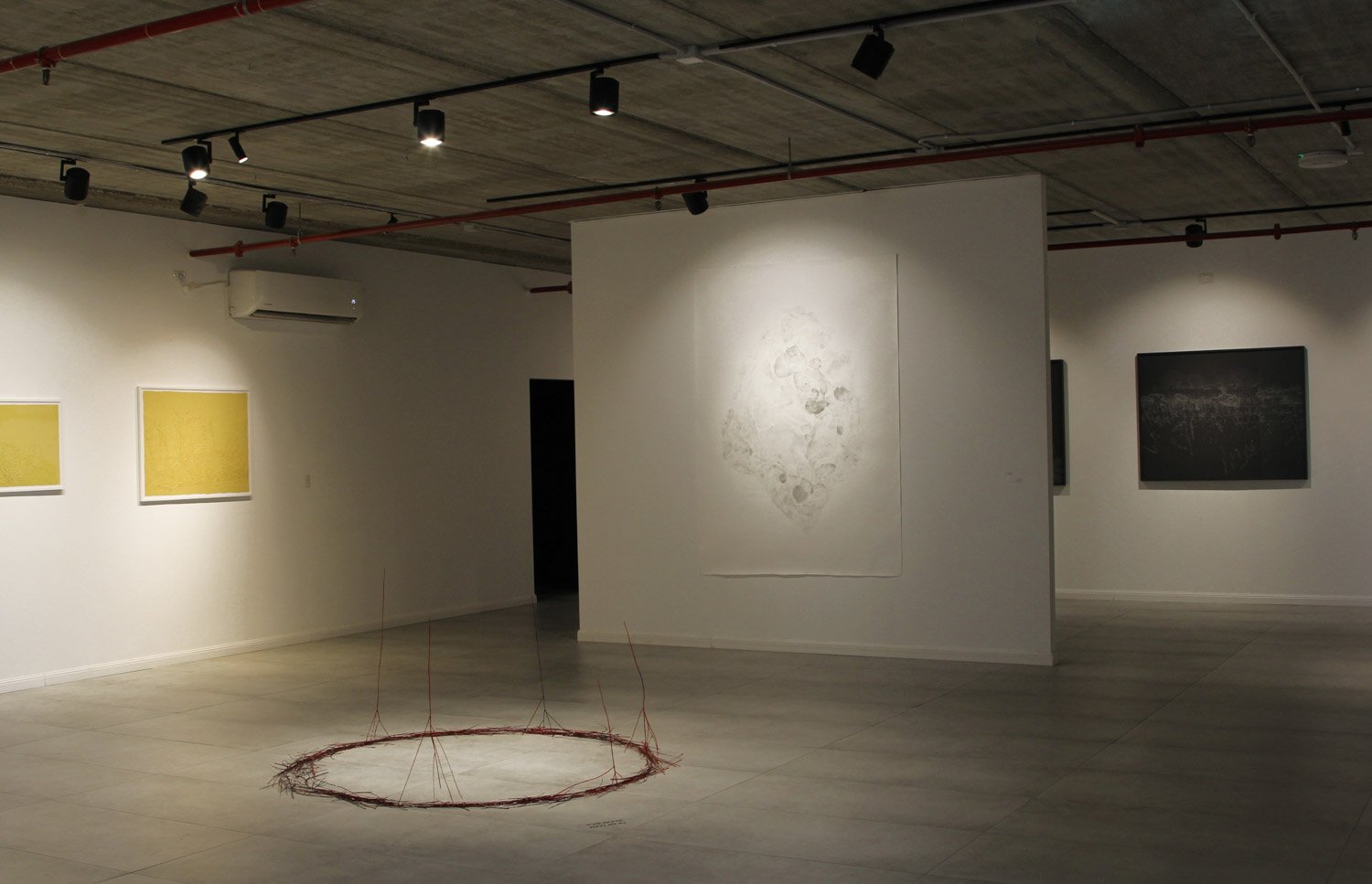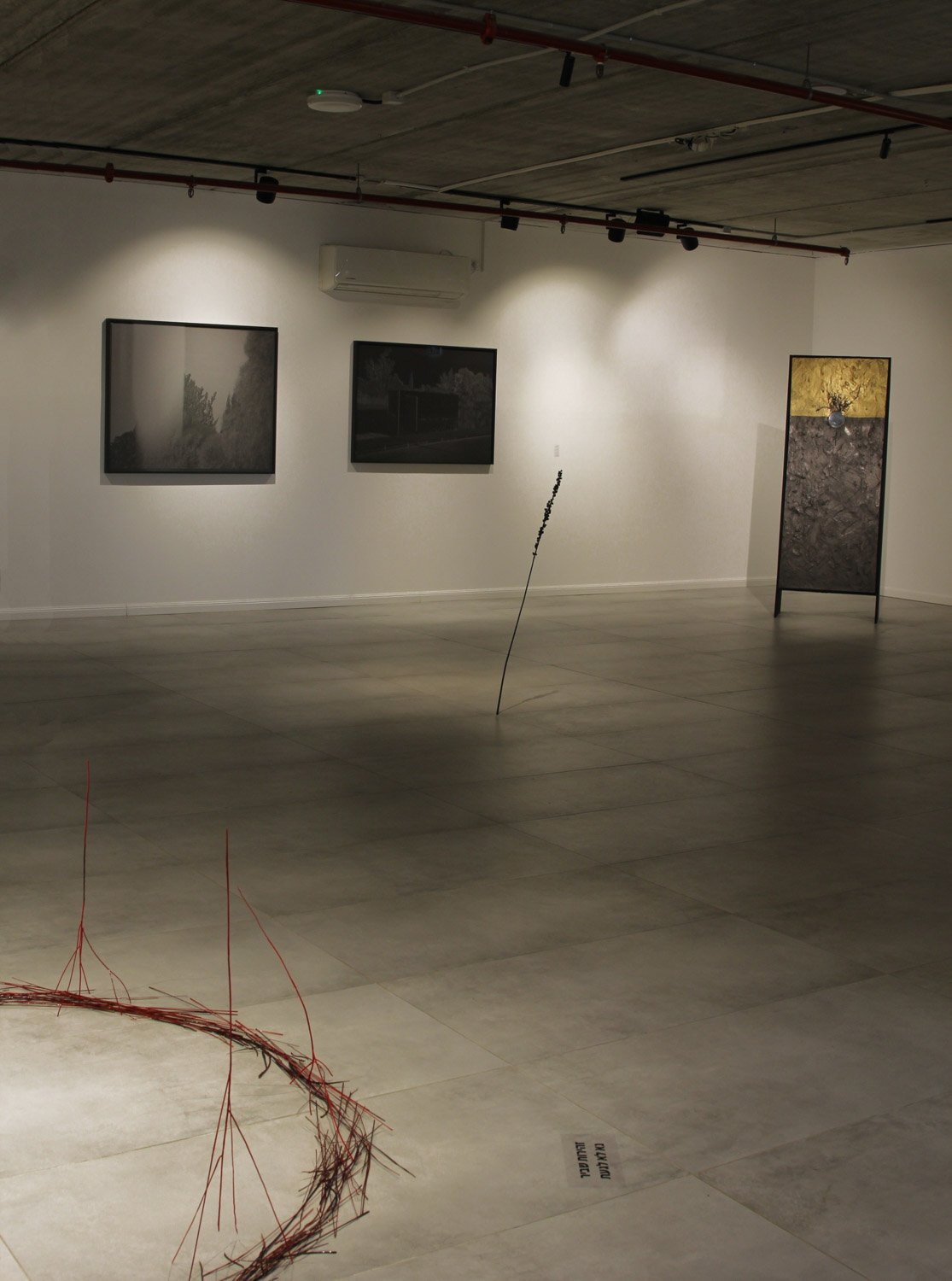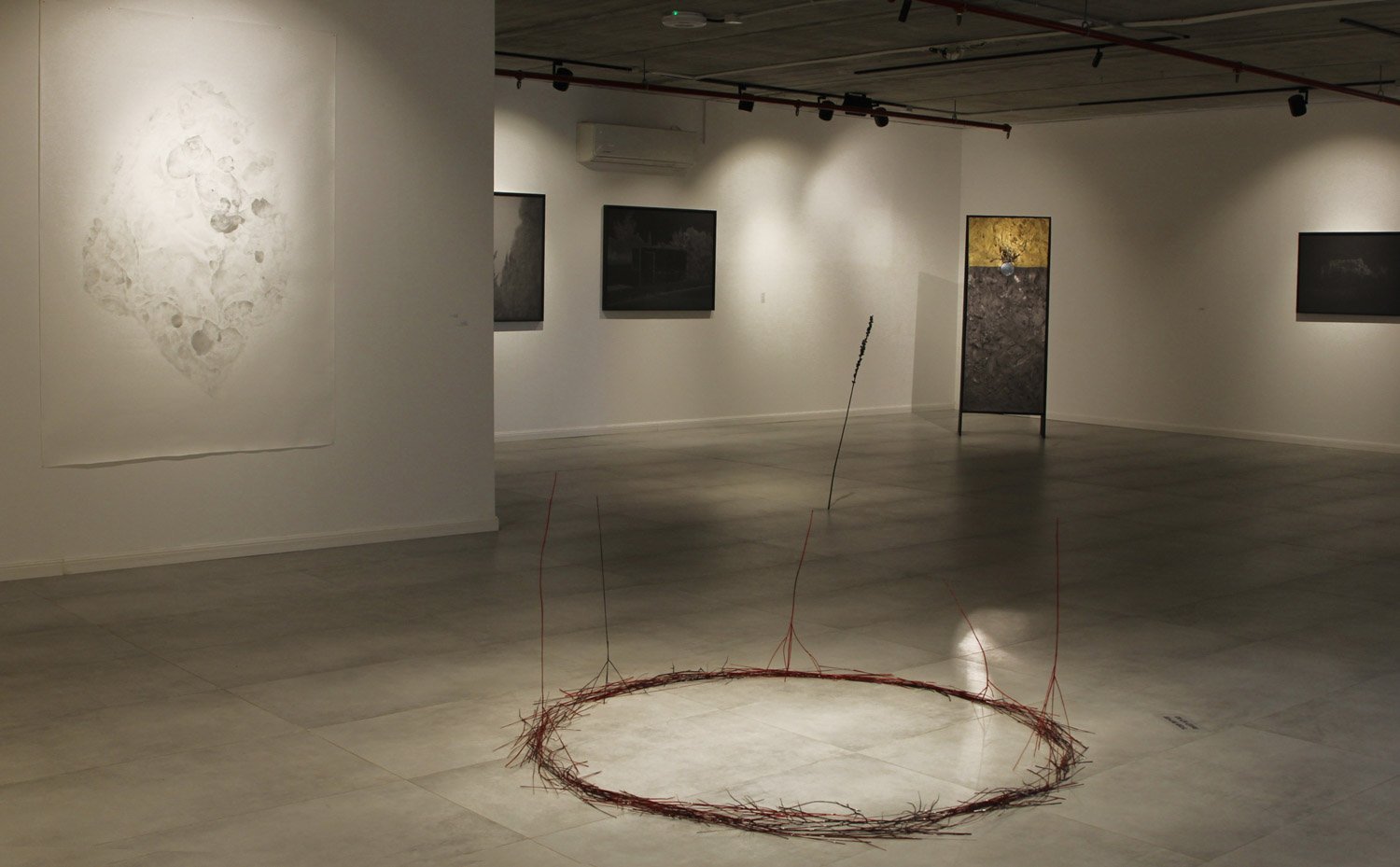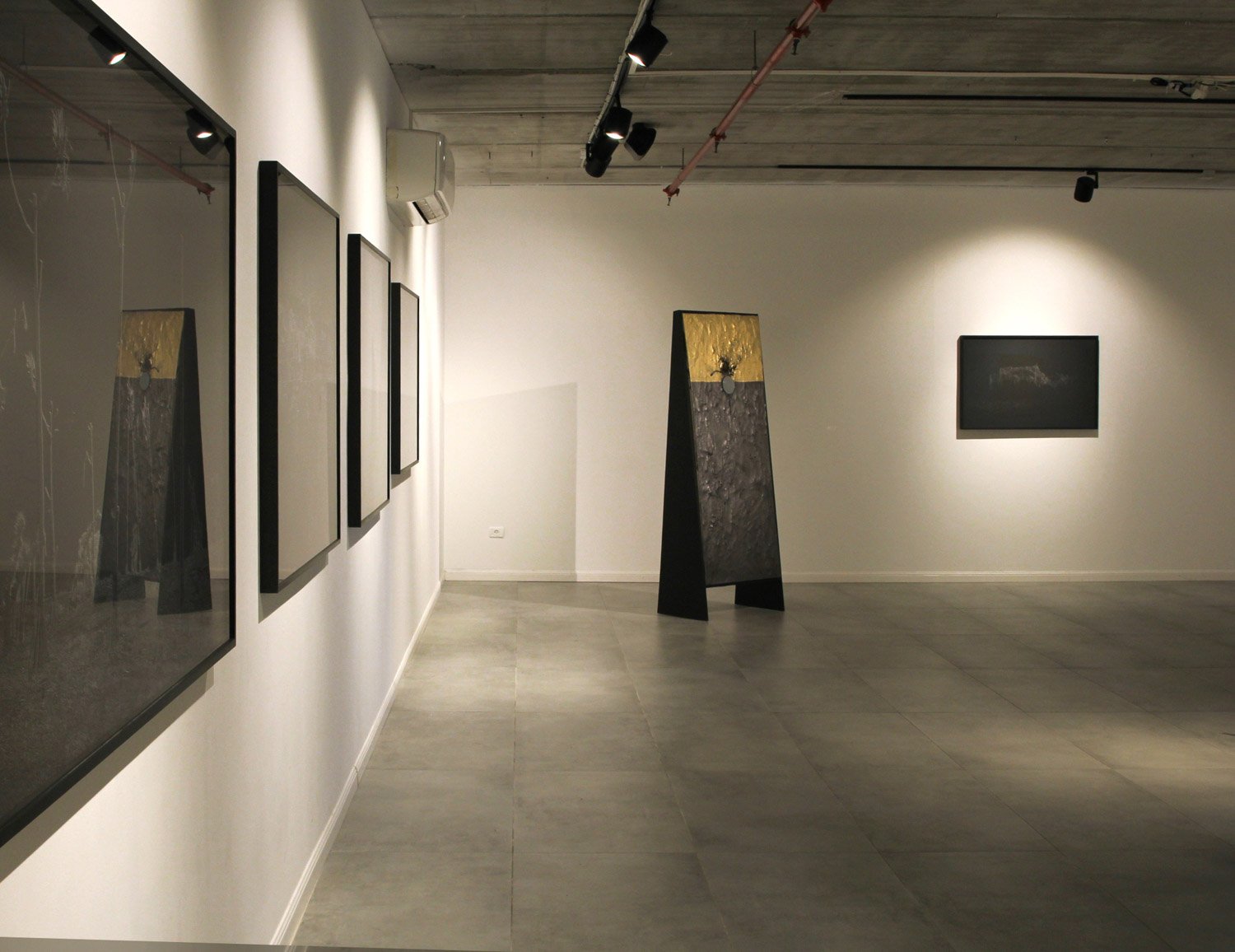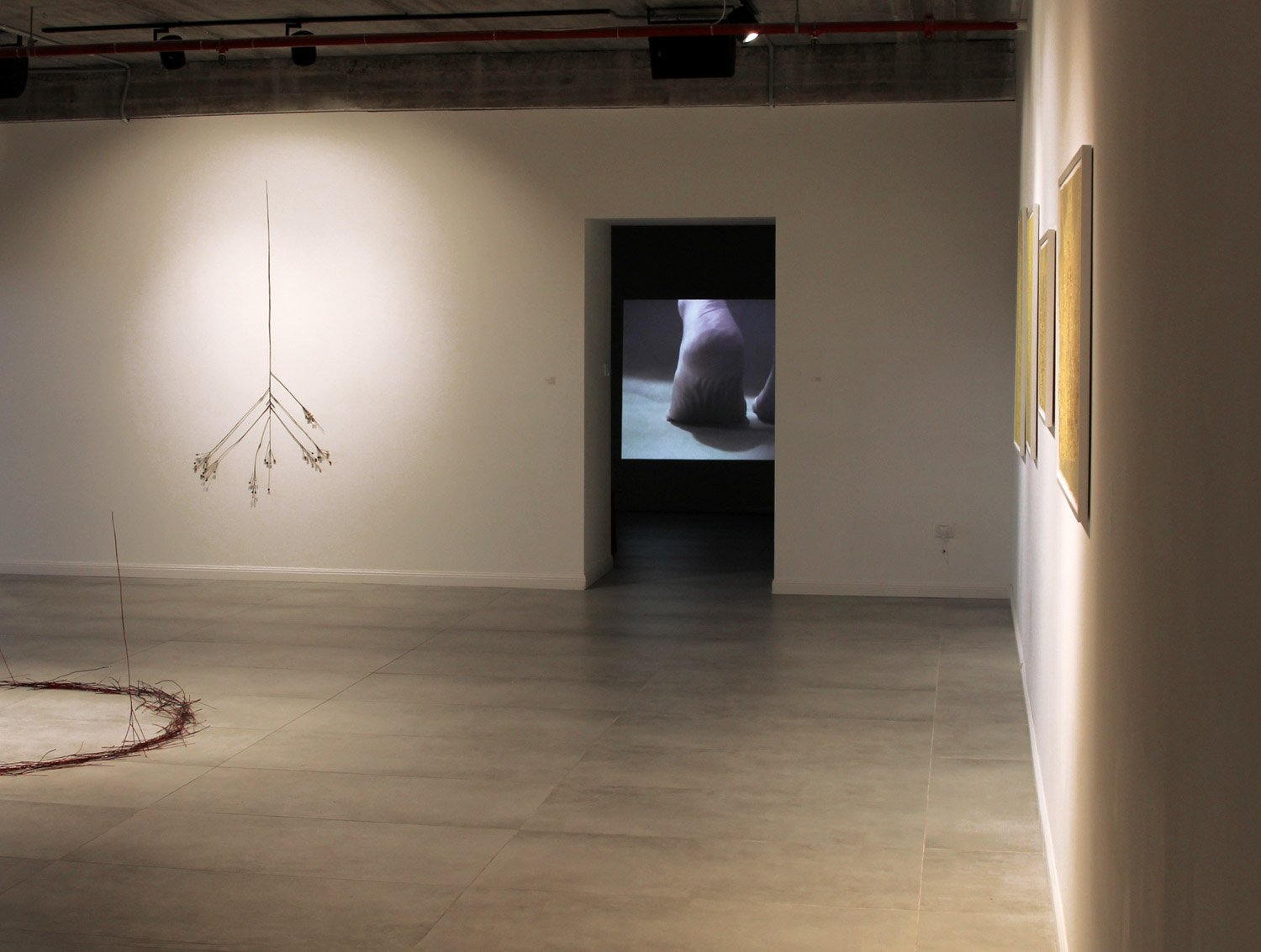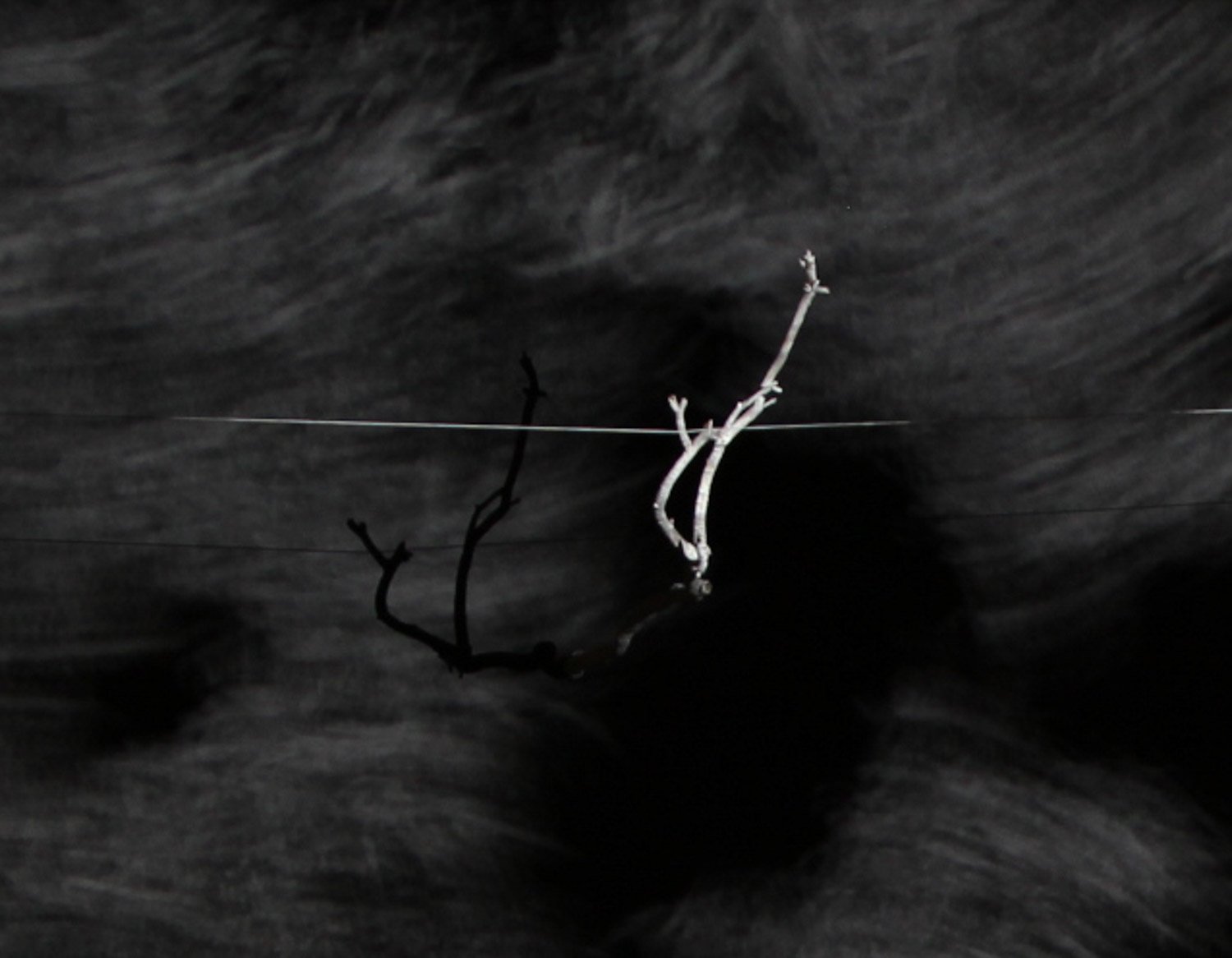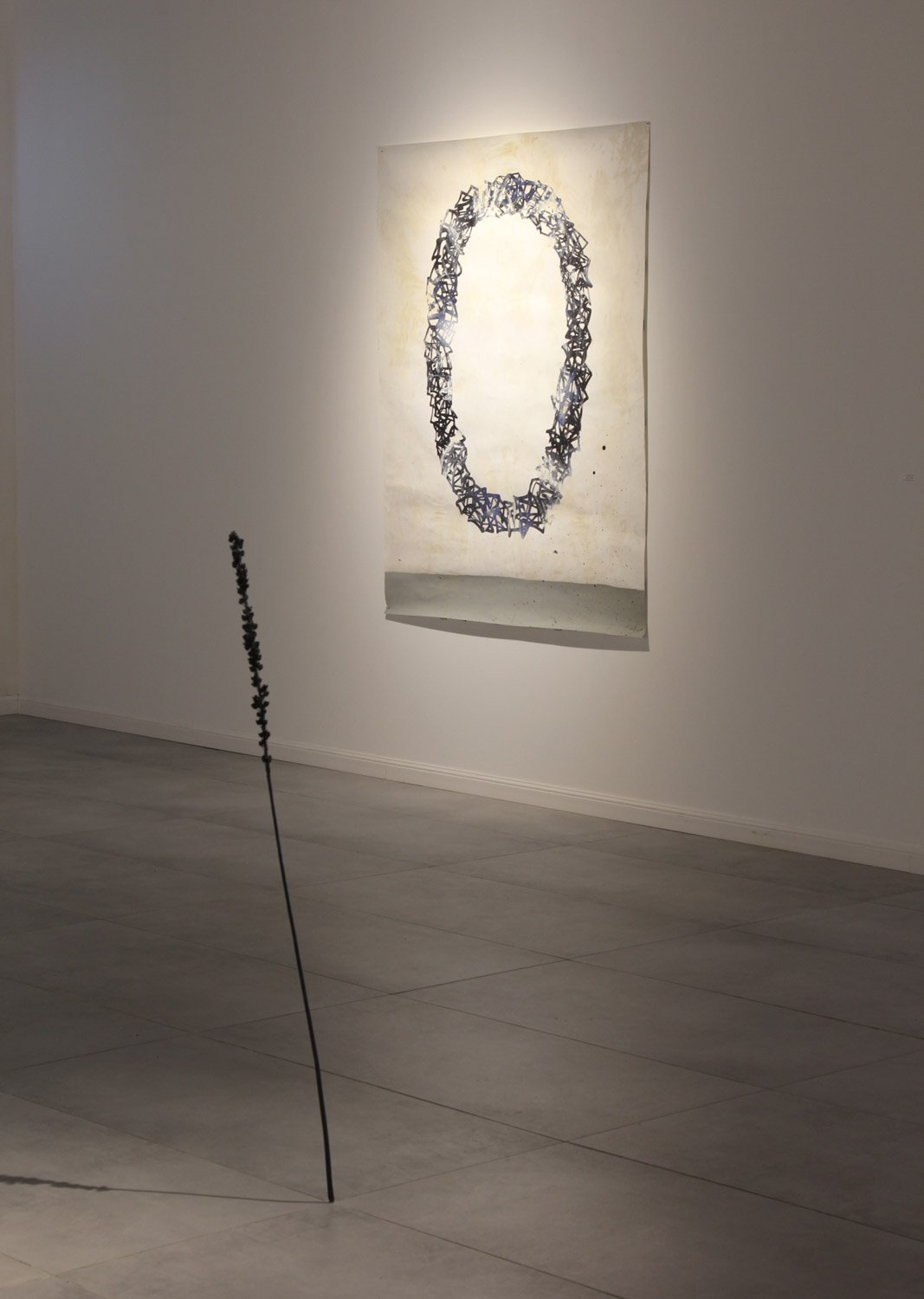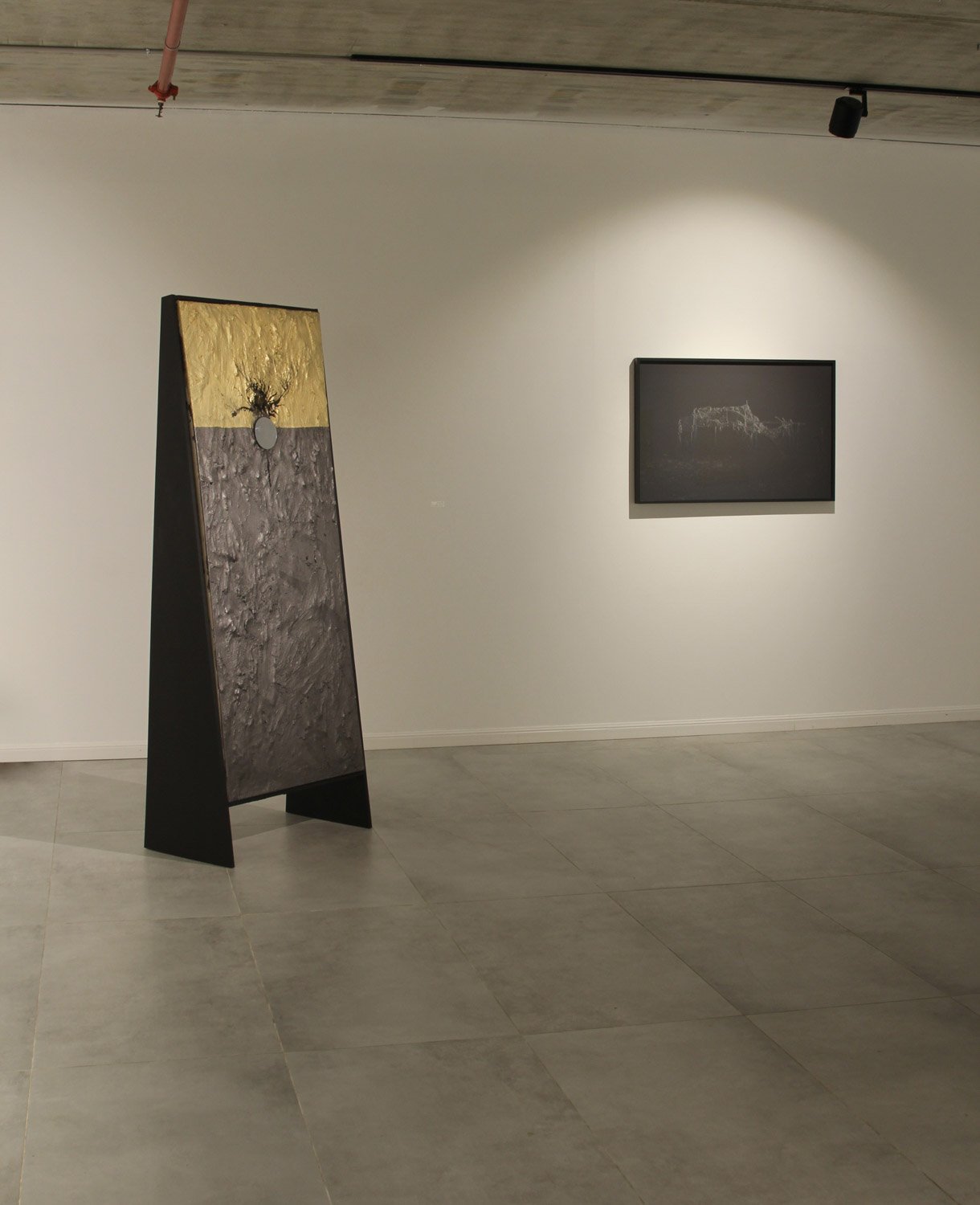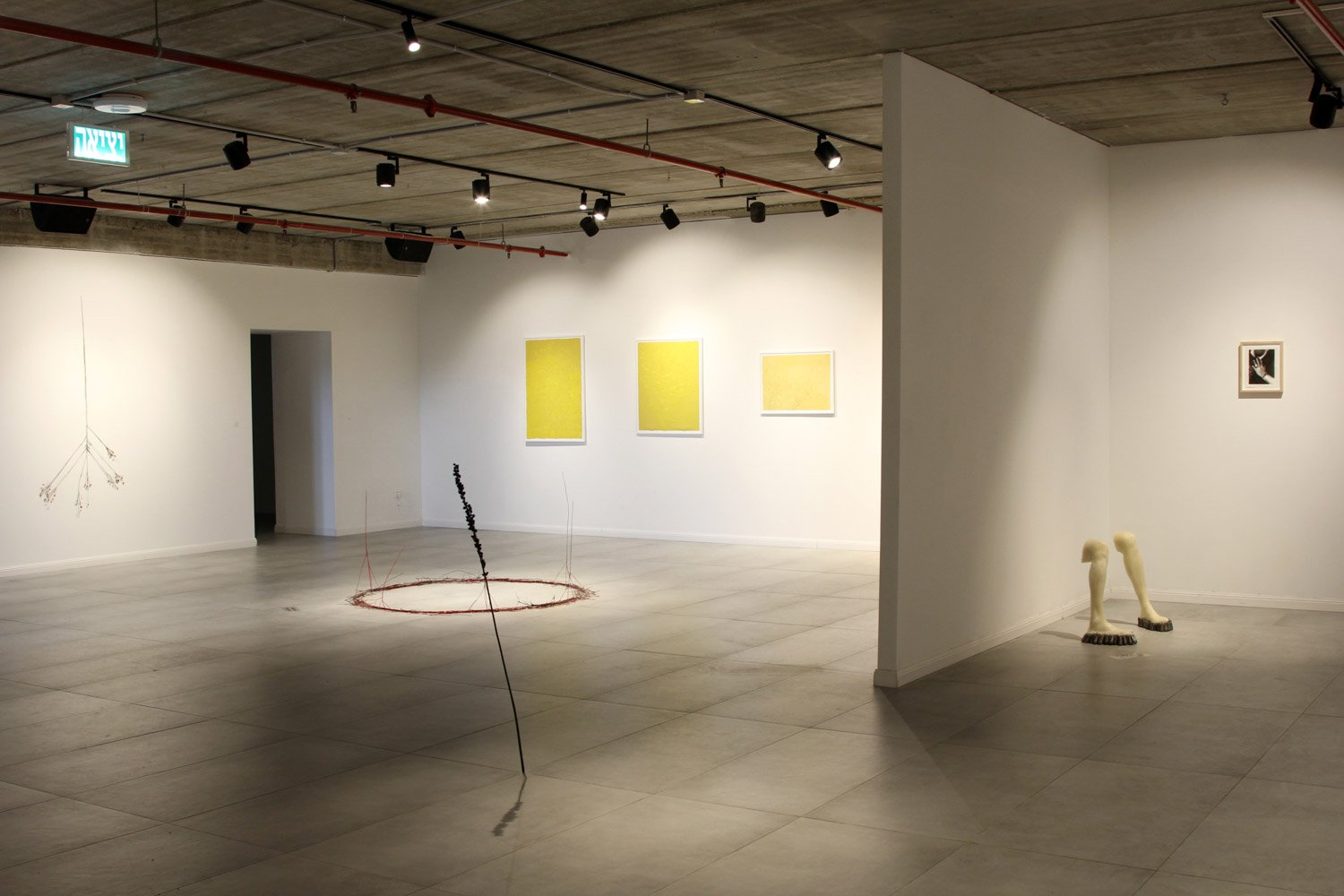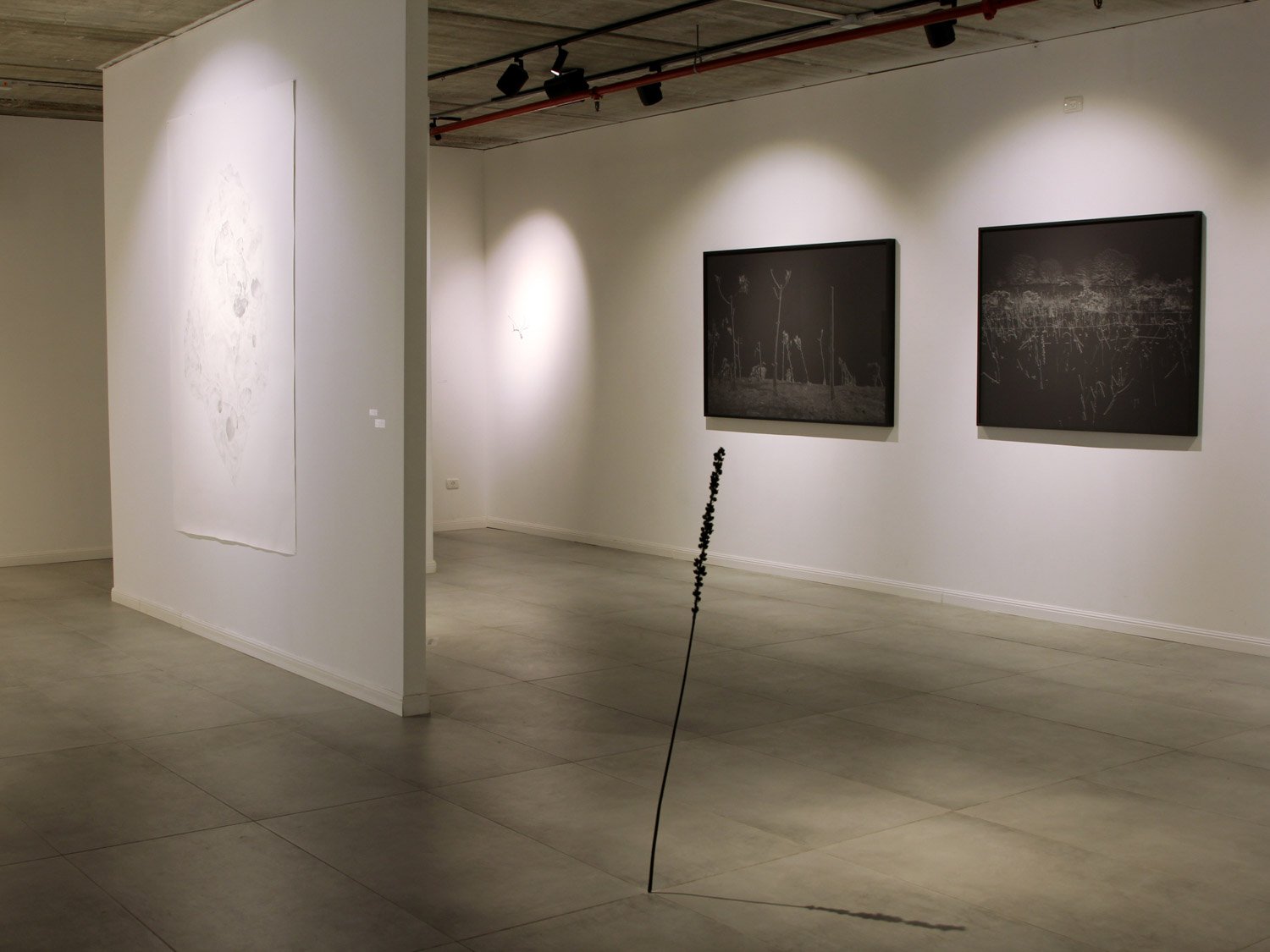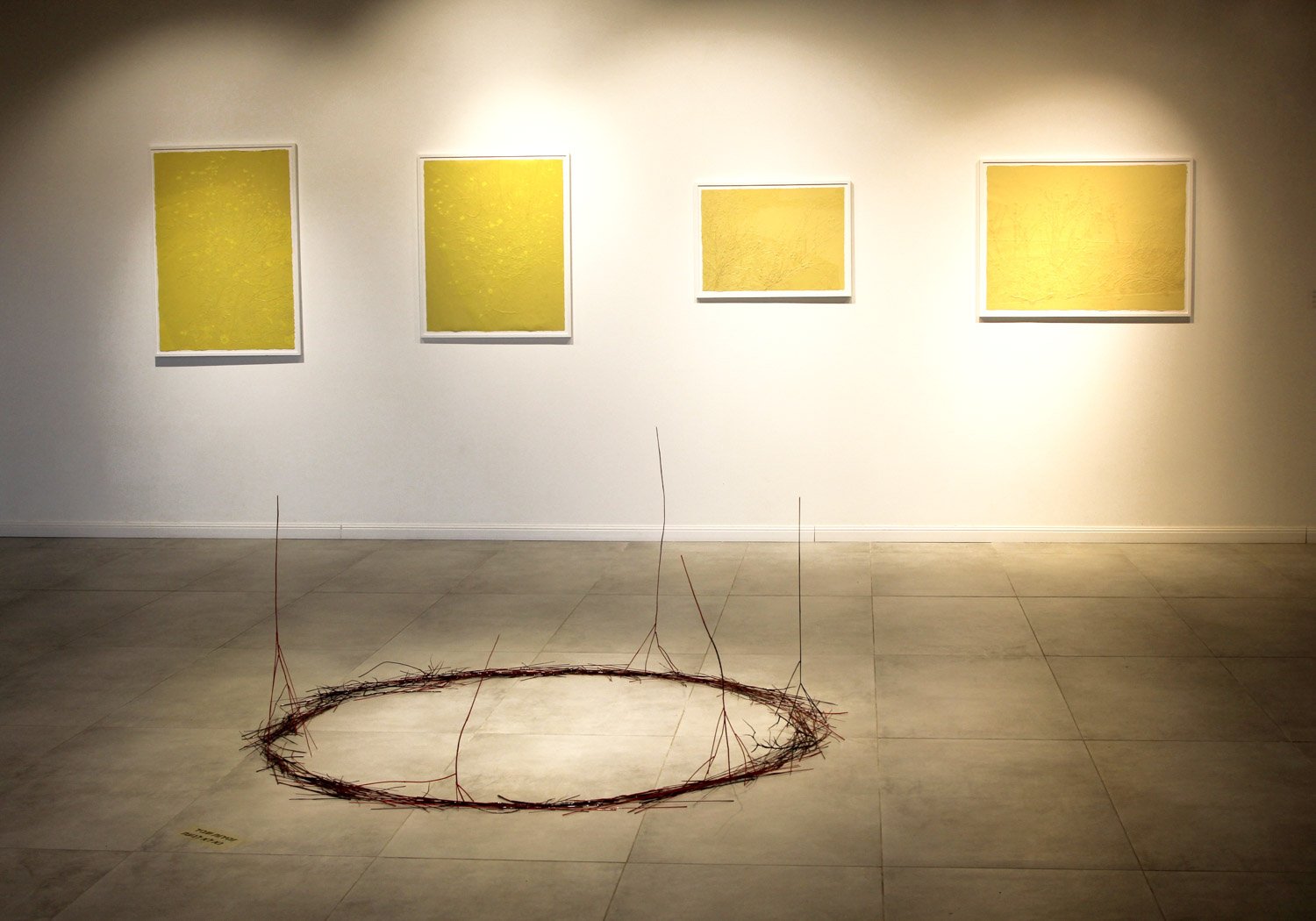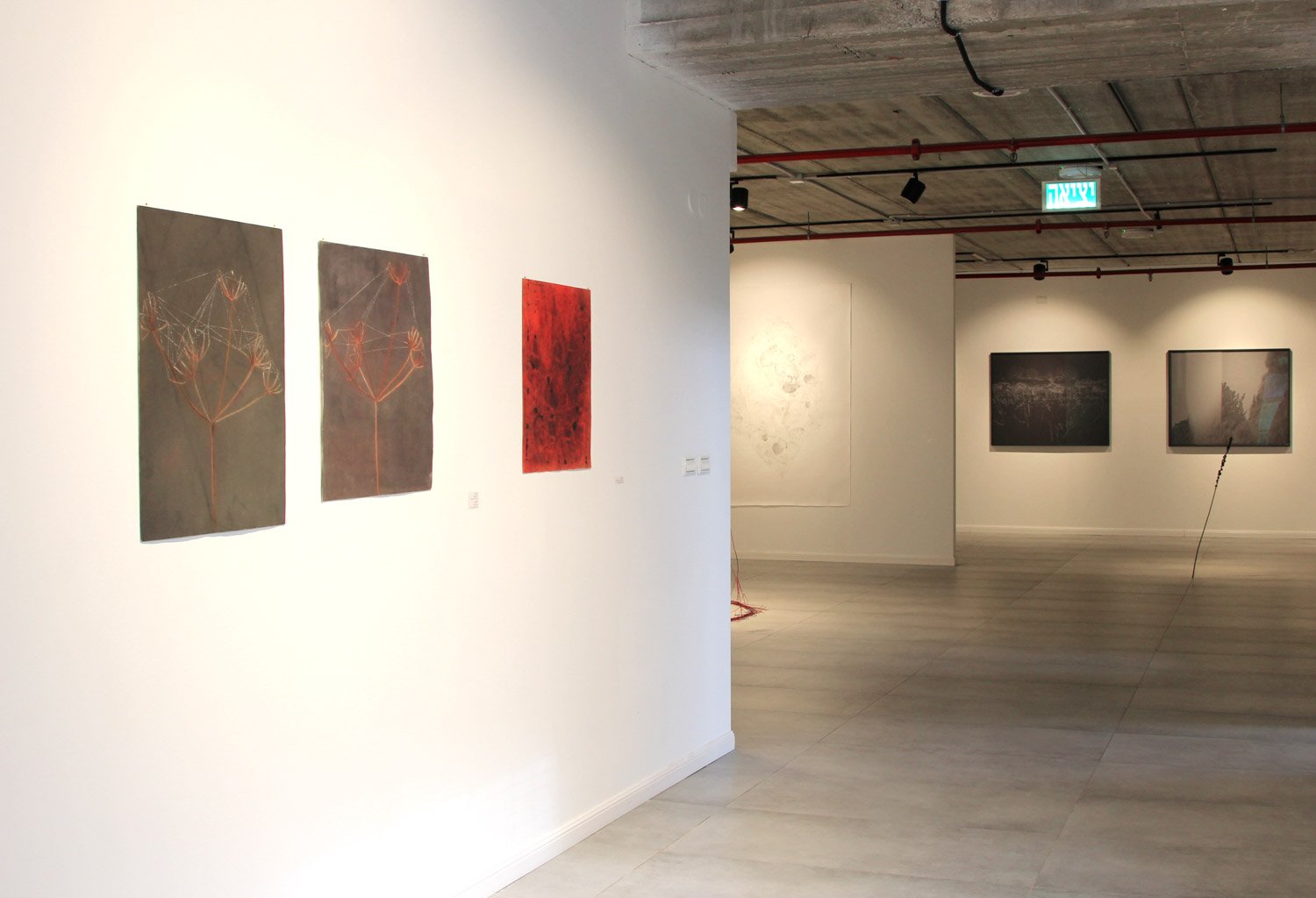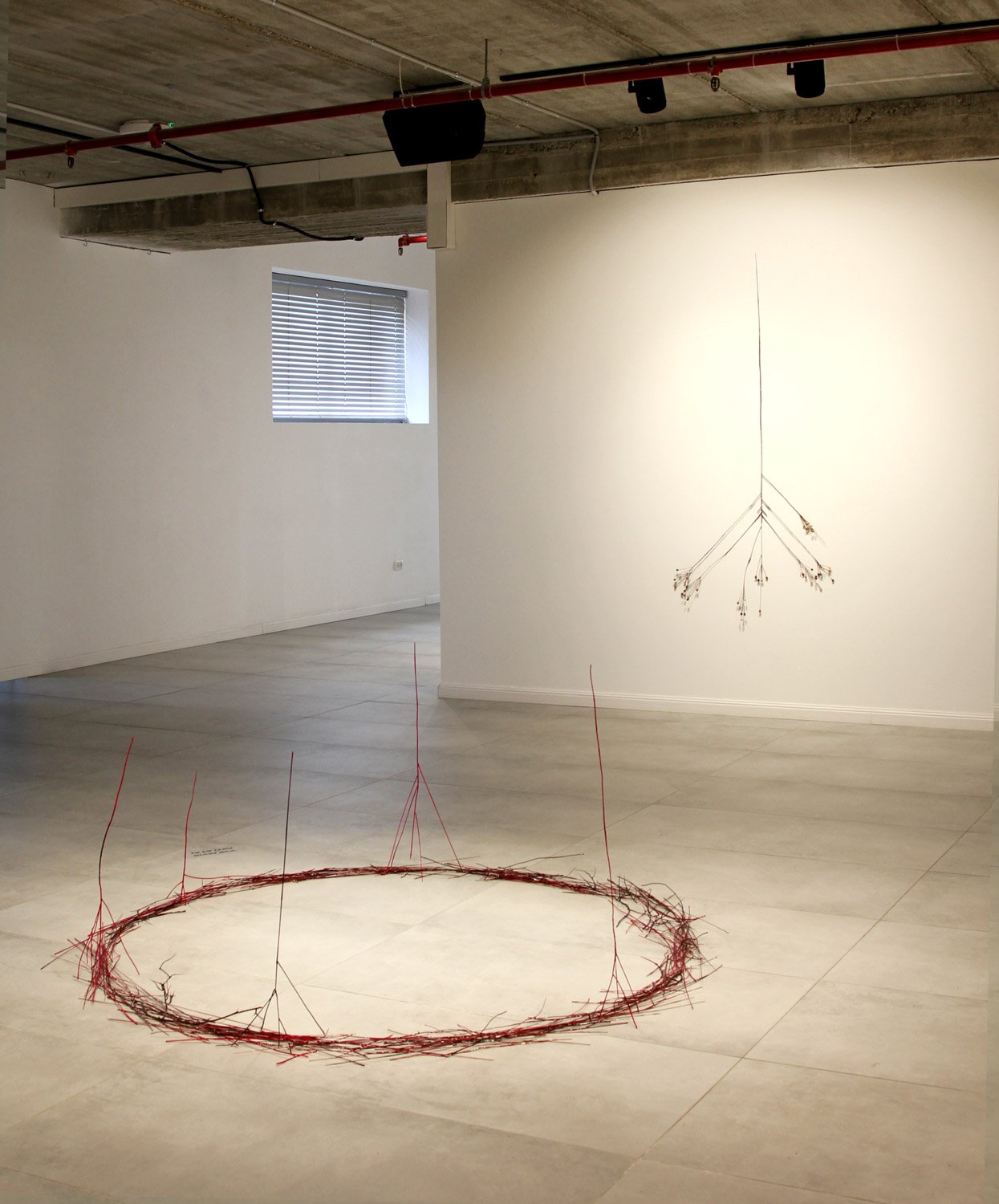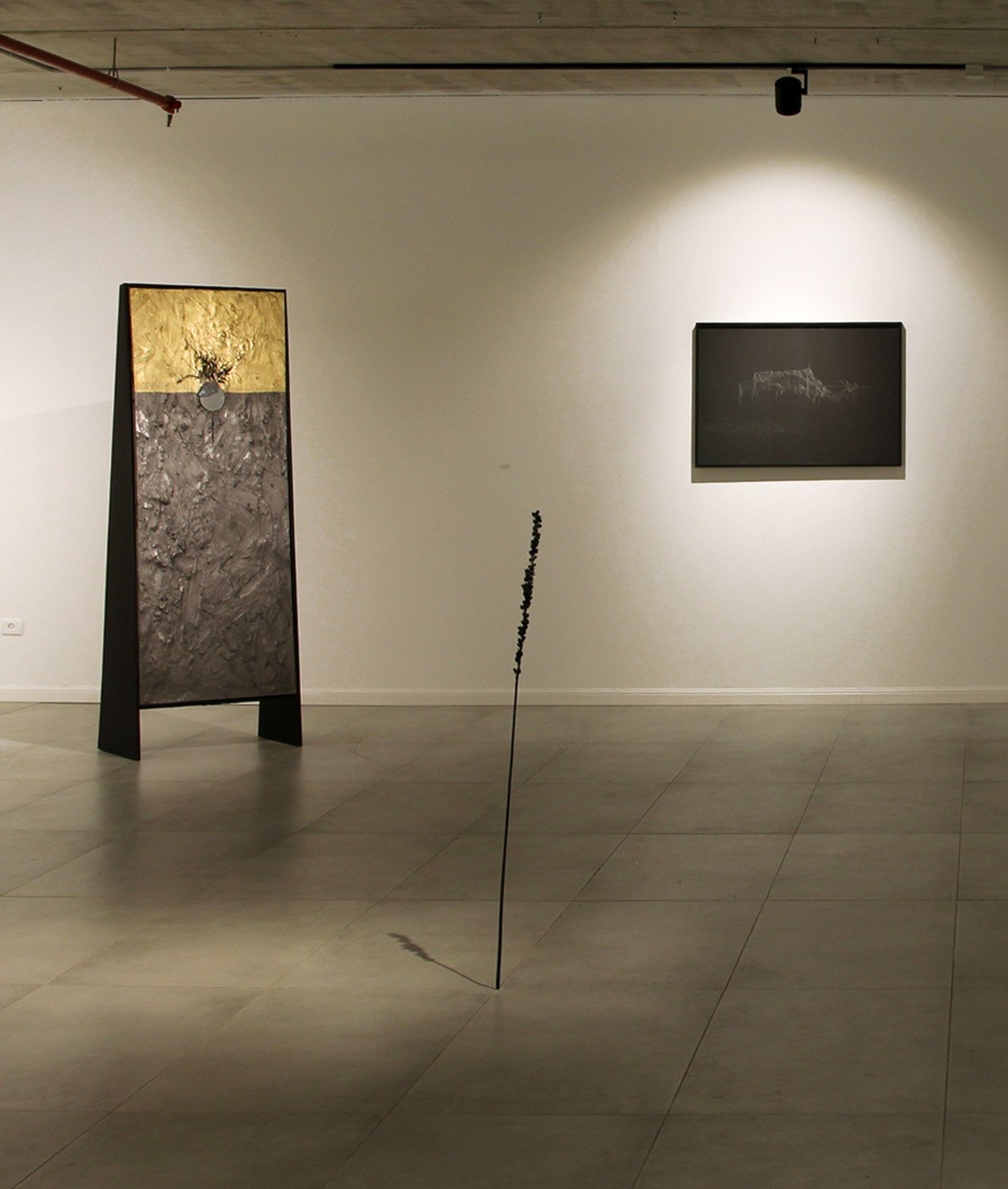לשיר מהענף השבור
לשיר מהענף השבור
עדנה אוחנה / הדסה גולדויכט / פיטר יעקב מלץ / אלה ליטביץ / אוהד מטלון / שולמית עציון / יונתן צופי / דיאנה קוגן / טליה קינן / דפנה קפמן
אוצרת: שירה פרידמן
15.12.23 - 27.01.24
לשיר מהענף השבור
העבודות שבתערוכה עדינות, לעתים שבריריות ממש. הן מציגות רגעים של פגיעוּת בטבע ובסביבתו: רוח בצמרות עצים, שורשים, שברי ענפים הנושאים לעתים שרידי פריחה, פרחים, סלעים ושיירי מדורה. הטבע דרוך. לעתים הוא מסנוור, לעתים חשוך ושרוף. נוכחותו המתעקשת ביצירות כורכת אותן יחד. באמצעותו, הן מתלכדות למעין רצף: יממה אינסופית, ספק הווה מתמשך, ספק עצירה המאפשרת הכרה בנוכחותה של כמיהה עמוקה, מתמדת, אל מה שנעדר או שאינו בר-השגה מלכתחילה.
מנגד לטבע מבליחה בעבודות גם נוכחות אנושית, אלא שזו נותרת תמיד מקוטעת וחמקנית.
בלב התערוכה ניצב פסלה של אלה ליטביץ: חצב יחיד, מבודד ומפוחם. החצב הוא צמח בר ים-תיכוני איתן ורעיל. שורשיו חוצבים להם דרך אל עומק האדמה, ושדרת פרחיו הלבנה מבשרת את סופו של הקיץ. נוכחותו בזמן מעגלית ומתחדשת, עדה לעונות השנה ומבשרת על התחלפותן. בהיסטוריה המקומית שימש החצב לתיחום חלקות ושטחים, ורכש גם משמעות סמלית-מוסרית: את הגבול אין להסיג. אצל חז"ל, "חצבים לבנים מלאי פיח" מסמלים אנשים ש"אין תוכם כברם". ליטביץ מאמצת את התפישה הזו בעבודותיה, ובכך יוצרת מעין כפילות-יחס באשר לתכונות הסמליות המיוחסות לצמח. גם החומר עצמו –ברונזה מפוחמת, טורדת מנוחה – כמו מתנגד לחגיגיות של התפרחת הלבנה.
עבודת הווידיאו של שולמית עציון, שנוצרה במיוחד עבור התערוכה, מציגה צמרת עץ ששוכפלה, ומביאה אל הגלריה דיאלוג זעיר בין צמרת זו לבין כפילתה/עצמה. על העבודה שורה החרישיות הרכה של השעות הקטנות של הלילה, אך לצדה גם מתח: הצמרות החצויות חסרות שקט. הקרבה ביניהן נכספת ואינה מתאפשרת. הניסיון להתקרב שב ונשנה, ואחריתו ריחוק. במרחק-מה מעבודת הווידיאו, ענף ניצב על חבל כלוליין. הוא מניע אותו רכות הלוך ושוב וכך מחזיק את נפילתו על בלימה. האיקליפטוס שאת צמרתו ברוח לכדה עציון מופיע רבות בשירה העברית, ומזוהה באתוס הציוני עם חוסן ועם ייבוש הבִּצות – אקט של כיבוש הטבע, שיש בו מן המרפא אך גם מן ההרסני.
בין האפלה לזריחה, בשעות הפגיעות של היממה, אוהד מטלון מצלם נופים לימינליים: עצים הנדמים לנוודים, מבנה ארעי ומט לנפול, שלט במרכז שדה קוצים המזהיר מפני מוקשים. בתצלום שנעשה אקטואלי וטרגי נראית באפלה מיגונית בכפר עזה. על דפנותיה מתנוסס ציור אידילי של שדות הנגב הפורחים. כשהשעות מתבהרות, קרן שמש מלבנית חודרת בין צמרות העצים שברקע. זו יכולה להיראות כרמיזה לנשגב, אך היא ממחישה גם את העיסוק המחקרי של מטלון כצלם העסוק בין היתר באפשרויות האמנותיות הטמונות במדיום הצילום האנלוגי.
טליה קינן רושמת פיסות עצים, קוצים וענפים. הפרטים ברישומים מבליחים מתוך החשכה, מזדרחים כשעולה האור. ההתעכבות על כל פרט מאפשרת להבחין ביופי של עמודי תפרחת הקוצים, להשתהות על זר קורי עכביש המתנצנץ באלומת אור, לעמוד עוד רגע מול האצטרובלים הסגורים, אשר צורת החרוט החלקה שלהם מונגדת למחטים הדקות והדוקרות של האורן.
הרישום של דיאנה קוגן מתרכז באלמנט יחיד בנוף ומקדיש לו את מלוא תשומת הלב: אבן מונומנטלית בעלת פני שטח ירחיים, רשומה בקווים בהירים ואווריריים, אשר כמו מנסה לפרוץ את מצע הנייר ולרחף בחלל. עבודה זו היא פיתוח והמשך של רישומי הפרוטז' שבהם חקרה ושחזרה קוגן מרקמים של אובייקטים, לרוב מן הטבע. האבן המרחפת מרמזת גם למפולת של אבנים, לתחושת אסון שעומד להתרחש או כבר קרה.
הצהוב והזהוב של שדות חרציות הבר בציוריו של יונתן צופי מתאפיינים בהבדלי גוונים דקים ועדינים, ומעוררים תחושת סנוור דחוסה ומרוכזת. בציורים, שדות הבר הם כמו מדבריות של חול זהוב. שיא הפריחה חלף, והאביב מפנה מקומו לקיץ. הפרחים שנותרו עומדים ניצבים כמו קווים מתוחים בין הפרח לשמש. גם הם עצמם שמשות זעירות, מאומצות. תהליך הציור של צופי מחקרי, פיסולי ומתמשך. תחילה הוא מצייר את הפרחים על מצע פלסטיק, כל פרח כאובייקט נפרד. אחר כך הוא מקלף אותם ובכך מנכיח את החומר האקרילי כאובייקט עצמאי המועמס על מצע הנייר.
קווי האופק והקווים המעגליים בעבודותיו של פיטר יעקב מלץ הם בעלי איכות טרנסצנדנטית, אל-חומרית. ניתן לראות בהם מעין ביטוי ויזואלי של נצח מחזורי ומולו של זמן ליניארי המתאפיין בתהליכי התהוות וכיליון. בעבודות אלה, המופשטות מן הרגיל בגוף יצירתו של מלץ, הצורות האובליות נפתחות כמעין שער לעולם, ואילו הזר המושחר מתחבר למוות, לזרי אבלות, ושייך לסדרה שבה פירק והרכיב את הראי של סבתו שנפטרה.
הזמן הנצחי, המשורטט כמעין מעגל אשר אוצר עוצמה וכוח תרפויטי, נוכח גם בעבודותיה של דפנה קפמן. בעבודות אלה, שנוצרו במיוחד עבור התערוכה, ניצבים זרדי זכוכית במעגל. כמה מהם מזדקרים במאמץ, אחרים קרסו אל הארץ. הזרדים, בצבעי אדום ואדמה, נראים כמדורה נטושה: אתר התקבצות שסימל בעבר חום, חיוניות ושלמות, וכעת נותר מנוכר וריק מתוכן. האש הנעדרת מסמלת גם את האנושיות ואת אורה הדועך. אלא שמקור העבודה דווקא באש שאינה נוכחת בה: היא-היא זו שאיפשרה לקפמן להתיך את הזכוכית לכלל דימוי. על הקיר, לצד המעגל, תלוי פסל בדמות ענפי אזדרכת. הענפים פונים מטה, בניגוד לאופן צמיחתם הטבעי. כמה מן הפירות הרעילים שלמים וחיוניים, אך אחרים נושרים קמוטים וקמלים.
תחושה מכמירת לב עולה משתי עבודות של עדנה אוחנה, שבמרכזן הגוף המקוטע. האחת נוצרה בעקבות אירועי הזוועה של השבעה באוקטובר: ציור קטן ובו מתייחסת אוחנה ל"אונס לוקרטיה", סיפור מוכר אשר היה לנושא יצירות רבות בספרות ובאמנות הפלסטית. אוחנה מצטטת פרט מלא רגש מתוך ציור של טיציאן בנושא: ידה השמאלית של לוקרטיה הודפת את חזהו של סקסטוס, רעו של בעלה, קודם להכנעתה ולאונס. היצירה האחרת היא פסל שעווה בדמות רגליים הנראות מהברכיים ומטה, ומתייצבות על הארץ באמצעות משקולות זעירות. הניסיון הגשמי להתייצב מרכזי בעבודותיה של אוחנה, וקשור גם לחומריות של השעווה – חומר רפלקסיבי, חי ונושם, שניתן להסיק ממצבו ההווה את עתיד ואת עברו.
עמידה, יציבות והמאבק על שיווי המשקל ניצבים גם במרכז עבודת הווידיאו של הדסה גולדויכט: המאמץ של הבהונות לשאת את משקלו של הגוף כמעט עוצר את נשימתם של הצופים. רעידת הרגל מעידה על קריסה קרובה. גולדויכט מתייחסת בעבודה לתנועת הרגליים בזמן אמירת תפילת הקדושה: עלייה וירידה שלוש פעמים. אלא שבעבודה זו, תנועת הרגליים אינה פרי המקצב או השאיפה להתעלות, ומיתרגמת לחוסר יציבות ולמתח לנוכח אפשרות קריסתו של הגוף החסר.
כל העבודות הללו, וכמוהן גם נושא התערוכה, נבחרו בחודשים האחרונים מתוך האבל הכבד על מות אמי – ולצדו החששות הכבדים לגבי עתידה של המדינה. אז באו זוועות השבעה באוקטובר, והאבל האישי התלכד עם הקולקטיבי.
את שם התערוכה, "לשיר מהענף השבור", מצאתי בבלוג "מתחת לשולחן" של דרור בורשטיין. הוא לכד את עיני ולא הרפה, ומהווה מבחינתי דרישה ותקווה לימים טובים יותר, שבהם נוכל – לצד השבר – גם לשיר לטבע ולאדם באשר הוא אדם.
שירה פרידמן
אוצרת
To Sing from the Broken Branch
Edna Ohana, Hadassa Goldvicht, Peter J Maltz, Ella Littwitz, Ohad Matalon, Shulamit Etsion, Yonatan Zofy, Diana Kogan, Talia Keinan, Dafna Kaffeman
The works in this exhibition are delicate, sometimes breakable. They represent moments of vulnerability in nature and the environment: wind in the tree boughs, roots, fragments of branches that occasionally bear the vestiges of blossoms, flowers, stones, and the embers after a bonfire. Nature is on alert. At times it is blinding, at times dark and singed. Its stubborn presence in the works binds them together. Through this presence, they merge, forming a kind of continuum: one endless day, which could occur within never-ending time, or could be a pause that enables recognition of a deep and persistent longing, for that which is absent, or was never attainable in the first place.
As a contrast to nature, a human presence also emerges from the works, yet always remains truncated and elusive.
Ella Littwitz’s sculpture stands at the heart of the exhibition: a single drimia plant, isolated and charred. The drimia is a hearty and poisonous Mediterranean wildflower. Its roots dig their path deep into the earth, and its spine of white flowers heralds the summer’s end. Its presence in time is cyclical and regenerative, bearing witness to the seasons of the year and announcing their passing. In local history, the drimia delineated lots and territories, and also acquired a symbolic-moral meaning: Do not trespass. For the sages, “white drimia flowers covered in soot” represent people whose “exterior belies their interior”. Littwitz adopts this conception in her works, thereby creating a kind of double meaning for the symbolic qualities attributed to the plant. Even the material itself – charred bronze - disturbs tranquility – as if resisting the festivity of its white flowering.
Shulamit Etsion’s art video, created especially for the exhibition, presents the reconstructed crown of a tree, and brings to the gallery a small dialogue between this tree bough and its twin. The work is permeated by the soft silence of the wee hours of the night, yet there is an accompanying tension: The tree’s halved crowns are restless. They covet intimacy yet it is not attainable. The endeavor to move closer recurs again and again yet ends in alienation. At a certain distance from the art video, a branch stands upon a rope like an acrobat. The rope propels it lightly over and over, thereby holding it up and stopping it from falling. The eucalyptus whose crown Etzion has captured appears frequently in Hebrew poetry and is associated with the Zionist ethos of resilience and draining the swamps – an act of conquering nature, which has healing qualities yet is also destructive.
Between darkness and daybreak, during the day’s most vulnerable hours, Ohad Matalon photographs liminal landscapes: trees resembling nomads, a rickety makeshift building, a warning sign in the middle of a thistle field cautioning against landmines. In a photograph that has become timely and tragic, a migunit (a rectangular concrete outdoor bomb-shelter structure) in Kfar Aza is visible in the darkness. Its walls display an idyllic painting of blossoming fields in the Negev. As dawn comes, a rectangular sunray penetrates the boughs of the tree in the background. While this might seem like a hint at the sublime, it also illustrates Matalon’s involvement in research as a photographer engaged, inter alia, in the artistic possibilities inherent in the medium of analogue photography.
Talia Keinan sketches fragments of trees, thorns, and branches. The objects in the drawings emerge from within the darkness, twinkling as the light rises. Lingering on every detail enables the discernment of the columns of blooming thorns’ beauty. It makes it possible to pause before a bouquet of spider webs glittering in the beam of light, to stand one more moment before the closed pinecones, whose smooth, etched form contrasts with the pine trees’ thin, piercing needles.
Diana Kogan’s drawing focuses on a single element in the landscape, devoting it complete attention: a monumental rock with a cratered lunar surface, sketched in light and airy lines, as if attempting to break out of the paper support and hover in the exhibition space. This work is a progression and continuation of Kogan’s frottage drawings, in which she researched and reproduced textures of objects, mostly from nature. The hovering rock also hints at an avalanche, a sense of a tragedy that is about to happen or has already occurred.
The gold and yellow of the wild chrysanthemum fields in Yonatan Zofy’s paintings are characterized by slight, subtle differences in tone, and elicit a sense of compressed and concentrated glare. In the paintings, the wild fields resemble deserts of golden sands. The peak of blossoming has passed, and the spring is clearing the way for the summer. The flowers that remain standing point upwards like lines stretching from the flower to the sun. They themselves are tiny, intensive suns. Zofy’s painting process is research-oriented, sculptural, and prolonged. First, he paints the flowers on a plastic platform, each flower as a separate object. Then he peels them away, thereby granting a presence to the acrylic material as an independent object loaded onto the paper.
The horizontal and circular lines in the works of Peter Jacob Maltz have a transcendent, nonphysical quality. They can be seen as a visual expression of a cyclical eternity, contrasted with linear time characterized by processes of inception and annihilation. In these works, which are exceptionally abstract for Maltz’s oeuvre, the oval shapes open up like the gate to the world, while the blackened bouquet links to death, to funeral bouquets. They are part of a series where he dissembled his grandmother’s mirror and reconstructed it.
Eternal time, sketched as a sphere that safeguards might and therapeutic power, can also be found in Dafna Kaffeman’s work. In these pieces, created especially for the exhibition, glass hawthorns stand in a circle. Some prop themselves up with great effort, while others have collapsed to the earth. The hawthorns, in red and earth tones, resemble a forsaken bonfire: a gathering site which once symbolized warmth, vitality, and completeness, yet now remains alienated and empty. The fire, which is absent, also symbolizes humanity and its diminishing light. Yet the work’s source can be found in a fire absent from it: The very fire that enabled Kaffeman to melt the glass into an image. On the wall, beside the circle, hangs a sculpture in the image of chinaberry tree branches. The branches face downwards, unlike their natural manner of blossoming. Some of the poisonous fruits are full and vibrant, while others are drooping, wrinkled, and withered.
Edna Ohana’s works elicit a sense of heartbreak, each with a truncated body in their center. One was created following the atrocities of October 7th: a small painting in which Ohana references the “Rape of Lucretia”, a well-known tale which served as the motif for many literary and art works. Ohana quotes an emotional detail from Titian’s painting on the subject: Lucretia’s left hand deflects the torso of Sextus, her husband’s comrade, before she succumbs and is raped. The other work is a wax sculpture shaped as legs visible from the knees downwards, held standing by tiny weights. The corporeal attempt to balance is central in Ohana’s works and is also connected to the wax’s materiality– a reflexive, alive, breathing material, whose past and future can be inferred from its present state.
Standing, stability, and the battle for balance are also at the center of Hadassa Goldvicht’s art video: The toes’ efforts to bear the body’s weight almost take the viewer’s breath away. The trembling feet attest to the proximity of collapse. In the work, Goldvicht references the foot movements made when reciting the Kedusha prayer: raising and lowering the feet three times. Yet in this artwork, the foot movements are not the fruit of the rhythm or an aspiration to be uplifted, rather they translate into imbalance and tension in the face of the flawed body’s possibility of collapsing.
All these works, as well as the exhibition’s subject, were selected during recent months when I was deep in mourning following my mother’s death, accompanied by deep concerns about this country’s future. Then came the atrocities of October 7, and my personal grief joined together with collective grief.
I found the exhibition’s name, “Serenading from the Broken Branch”, on Dror Burstein’s blog, “Under the Table”. It caught my eye and would not leave me, and for me it signifies a demand and hope for better days when we will be able – alongside the shattering loss – to sing to nature and serenade humanity for being human.
Shira Friedman
Curator

